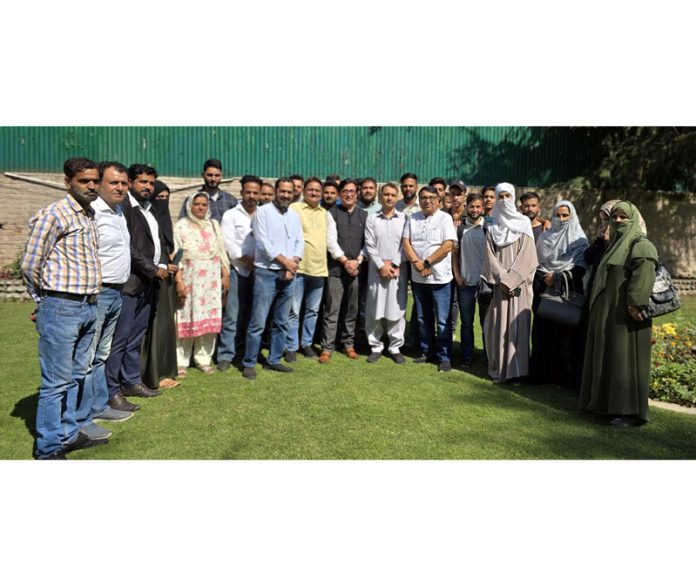Ely Buendia’s newest single “Bulaklak Sa Buwan,” the first off his upcoming November album, Method Adaptor , tackles misinformation, propaganda, and in his own words, how we “tend to take everything seriously, without first seeing the evidence.” The context shouldn’t be a mystery to anyone: disinformation is a hallmark of the times. Bulaklak is one artist’s reaction to that.
“ Mayro’ng naglalako ng pantasya, ‘yan ay delihensiya, makakadena sa pusod ng makinarya,” the song goes. (They peddle fantasy, an extortion scheme, chained to the navel of the machine.) To deliver his message, Buendia latches on to the central image of a flower on the moon.

It forms an alluring image in the mind. Imagine a flower in striking color growing out of an absolutely barren gray landscape. And just for its beauty, you’d almost want to believe that such a thing might exist, despite a mountain’s worth of science saying why it shouldn’t — you know, things like the atmosphere and all the other nilly-willy requirements of life.
But with the way people can be made to believe that the earth is flat nowadays, it’s probably not impossible to make someone eventually believe that yes, indeed, there is a bulaklak sa buwan . That’s at least one way of interpreting the song. But while interpretation can take on many shapes and forms, here are some square and solid facts on the song, straight from the artist: The title comes from a book on misinformation, which contained a passage on “stuff being as rare as a flower on Mars.
” He switched Mars to moon, because he guessed it sounded more poetic than Mars. The metaphor does revolve around how “there are things in this world that need to be, kind of, vetted, in terms of being factual.” For the overall sound, Buendia wanted the song to be as “tight” and “current” as possible so people can “be focused on what the song is saying” and not be “thrown off by the sonics of it.
” While Buendia was among the many artists and musicians who supported former vice president Leni Robredo in the last presidential elections, which was marred by disinformation, the song isn’t a product of that, the artist says. “No, not really [it’s not a product of the elections]. I wasn’t thinking of the elections.
..although there was misinformation.
There’s misinformation everywhere until now. And [the song] is just sort of my opinion on the thing.” Documentaries, the artist says, also played a role in the song’s formation.
“And, I don’t know, I’ve just come to the conclusion that a lot of violence in the world and suffering are caused by people kind of blindly following ideologies — which aren’t bad, per se, but I think it’s dangerous when people don’t question it, and people don’t have an open enough mind to update whatever they feel about certain stuff, especially about things that are purported to offer the truth.” Buendia notes too how he was careful not to sound dogmatic as well when he was writing the song, and instead wanted to invite meaningful thought: “I made sure it doesn’t sound like ‘this is what I feel should be what the world is.’ It’s not fact.
...
But also, I wanted to make people kind of also think about the song they’re listening to...
[that] there’s participation on their part.” Play Video A personal journey While “Bulaklak Sa Buwan” sees Buendia offering a take on what is, by many marks, a societal ill, the Method Adaptor album is actually a personal journey of sorts for the artist. The last time he put out a solo album, the world was just around a year removed from what had been that time’s own biggest societal ill: obviously the Y2K bug.
The last time was about 24 years ago, and even then, the songs were originally written for Rico J. Puno, before Buendia said he fell in love with the songs. “ Na-in-love ako sa mga kanta, kaya naisip kong dapat siguro ako na lang ang magrecord nito ,” he told Inquirer back when Kodak cameras were apparently still being sold.
(I fell in love with the songs, so I thought, maybe I should record these.) Since then, Buendia has formed multiple bands such as Pupil, The Oktaves, Apartel, all of which operate within the boundaries of a certain genre (modern rock, RnB, and jazz in that order), and has collaborated with the likes of The Itchyworms, Cheats, and the late Francis M. Method Adaptor , Buendia says, is his attempt at trying to figure out who he is as an artist.
“I think that’s the reason why I was so inspired by [the new album], recording again, and writing songs again. You might say that I did have kind of an identity crisis as an artist and musician because after the breakup of the ‘Heads, there was just a lot of noise, with regards to what an Ely Buendia song should be and how it should sound like. And it was hard to filter all that.
” To cope, he said he had to “ adapt a methodology in my creative process,” Buendia said, emphasizing the italicized words, which formed the title of his new album. “That’s why I found it easier to work in genres. Like for Pupil, it was modern rock at the time.
So, that was the limit I set for myself — that you can only write songs that lend itself well to this genre. Same thing with The Oktaves, which was like country, rockabilly. And the same thing with Apartel, which was R&B, funk, soul.
So that made it easier for me to sort of filter whatever kind of process I needed in order to write a song.” While his first solo attempt came at quite a busy time — in between the penultimate Eraserheads album (Natin99), and the last (Carbon Stereoxide), and not to mention, a newborn in son Eon — Buendia’s second attempt at a solo arises from a much more methodical era, where he was able to practice defining, deliberately, the scope of his musical projects through the years. That working style carries over to the new album.
“I’m very inventive when there’s lots of parameters, and for this album, [the parameter] was, ‘What do I think an Ely Buendia album should sound like?’” In the past, there had been a creative motivation to rebel against the audience’s expectations, specifically coming from his and the Eraserheads’ biggest release, Cutterpillow , before “they retreated to the experimentalism of Fruitcake and Aloha Milkyway ,” as Inquirer had also written back in the day. Buendia said then, “ Obvious na ‘yun ang gusto ng masa , ‘ yung ganung tunog (Obviously, that’s what the masses wanted, that sound),” so they did the opposite. Before it was called Method Adaptor , Buendia played around with the word “amorphous” as the album title, seeing as how he has moved within various musical spaces with his myriad bands and collaborations.
But he eventually honed in on something more exact. “Instead of being sort of vague with with that ‘amorphous’ album title, I decided to be more specific and focus on what I’m good at, which is adapting, and the methodology of songwriting.” Curiosity would be the “main drive” for Buendia to start making the album, to see how the songs that had “piled up over the years would sound like.
” “And that was enough for me to start working on them,” he says, admitting feeling some pressure. This year, Buendia officially made the decision to gather those songs, and do the album, also partly crediting a working London trip, and the legendary Abbey Road Studios: “I was in London for work. I was, sort of, chaperoning Ena Mori on her UK tour.
And I mean, that city , it kind of inspires you to be really creative. And since I had stuff lying around, I just decided, oh, why don’t I record this somewhere? And Abbey Road was right there. So I booked some sessions in Abbey Road and tried out some of the songs that are in this album.
” “This album, kind of, is me trying to find out who I am as a musician, as a songwriter,” the artist says. – Rappler.com.



















